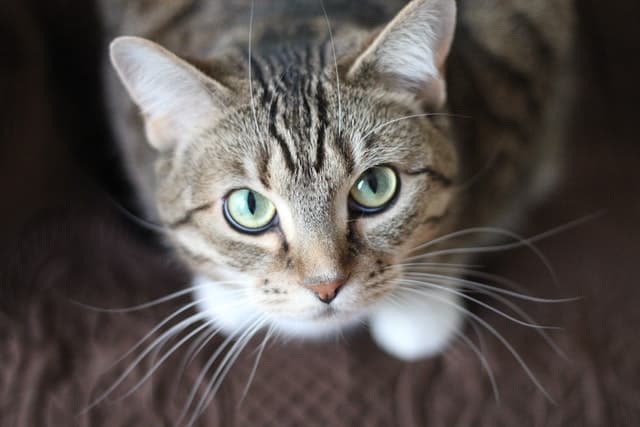
Sometimes the cat has problems with incontinence, i.e. an excessive amount of urine even outside the litter box: causes, symptoms and remedies for feline incontinence.
The cat is a pet that is very attentive to its personal hygiene and to the cleanliness of the litter box in which it usually needs: those who have adopted a cat know very well how important these aspects are for their feline friend and it is precisely for this reason that they tend to be alarmed immediately if the cat shows unusual signs such as going to the toilet outside the litter box.
Whether it is intentional behavior or not, if the fact is peeing out of the litter box is always a clear signal that the animal is sending and often and willingly represents the first indicator of a urinary incontinence problem in the cat.
In this article, we will cover the topic of the incontinent cat with causes, symptoms, diagnosis and remedies.
Incontinence in cats: what is it all about?
When the cat exhibits incontinence problems it is because it is no longer able to control the muscles of the urethra: in this way, the cat cannot keep the sphincter closed and consequently no longer decides when to urinate.
Hence, pee losses occur, also and above all outside the litter box: but be careful! Incontinence in cats is a sign that should never be underestimated, because it could be a sign of various health problems on a physical and psychological level.
Possible Causes of Feline Incontinence
When the cat is incontinent, therefore, he cannot control his urination and will have urine leaks that can be light (even a few drops) or much more abundant. Urinary incontinence due to the inability to control the urethra should not be confused with other typical feline behaviors, such as territorial marking.
Usually, urinary incontinence in cats can have one or more of the following causes:
– Urinary tract infections> among the most common causes of the problem of feline incontinence, it must be treated as soon as possible with the appropriate antibiotic therapy prescribed by the veterinarian. The bacteria responsible for the infection could reach the kidneys and cause severe kidney failure in the cat.
– Inflammation of the bladder> sometimes cats are prone to cystitis problems, which prevent them from holding their pee for a long time.
– Bladder stones> if your cat suffers from them, it is possible that the stones partially obstruct the flow of urine causing incontinence problems.
– Feline diabetes> untreated diabetes causes a great thirst in the cat, which will tend to drink much more water and consequently produce more urine. This can be difficult to hold and the cat may not make it to the litter box in time.
– Sterilization> in some cases, both male and female cats tend to suffer from incontinence problems following the sterilization operation. The solution is often in the hormone treatment of the animal.
Trauma to the tail or spine> A fracture or other type of trauma in these areas can cause incontinence in the cat.
– Bladder cancer> although it is a very rare disease in felines, this type of cancer can affect the cat. Watch out for symptoms such as lethargy, weight loss, difficulty defecating and urinary incontinence.
– Chronic renal failure> if the cat has a kidney problem he can leave drops of pee around the house, especially in places where he sleeps.
– Feline leukemia> Like kidney failure, FELV can cause small urinary losses especially during sleep.
– Neurological problems> if there are lesions at the neurological level (brain, spinal cord, brainstem) there may be damage to the control of the bladder.
– Congenital or age problems> sometimes the cat is born with some functional problem at the level of the urethra and / or bladder, often resolvable with surgery. Also, as the cat ages, the cat’s sphincter tends to weaken and cause incontinence in older cats.
Symptoms and signs of the incontinent cat
How can we tell if our cat is incontinent or not? A cat with urinary incontinence problems can show some very specific symptoms: emission of a few drops of urine after urination, loss of urine while sleeping, skin irritation due to contact with urine.
But be careful: finding wet spots around the house is not necessarily a sign of incontinence in cats. There could be different problems, such as polydipsia or polyuria, often related to the amount of water the cat drinks throughout the day.
Diagnosis and treatment of incontinence in cats
To correctly diagnose urinary incontinence in cats and the specific causes that lead to it, it is necessary to contact the veterinarian who will carry out a complete examination with specific urinalysis and any further tests, including an abdominal X-ray of the cat.
Depending on the specific causes diagnosed and the extent of the problem, the veterinarian will prescribe and administer the most appropriate drug treatment and any useful treatments, such as the temporary placement of a catheter or some surgical interventions such as urethral repositioning and the application of a permanent drainage device.
Incontinence in the elderly cat

As anticipated, the cat often presents problems of urinary incontinence as the age advances: the cat can be defined as elderly starting from 10 years of life, and it is precisely then that some typical problems usually begin to arise such as loss of bladder control and consequently urinary losses outside the litter box.
If the elderly cat becomes incontinent, it is essential to go to the vet who can recommend the most suitable treatments and remedies. The fundamental thing is to guarantee the elderly cat not only medical and pharmacological support, but also psychological: never scold the incontinent cat and treat him with even more gentleness and attention, to guarantee him a happy and serene old age.






